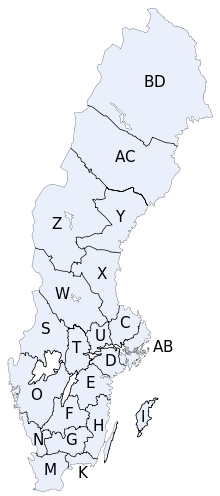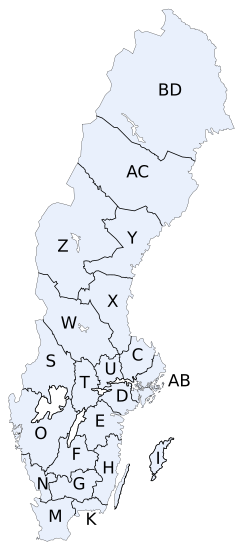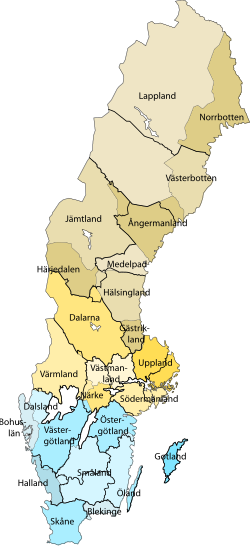Counties of Sweden
This article needs additional citations for verification. (March 2020) |
| Counties of Sweden Sveriges län (Swedish) | |
|---|---|
 | |
| Category | Unitary state |
| Location | Sweden |
| Number | 21 |
| Populations | Least: Gotland, 61,001 Most: Stockholm, 2,415,139 |
| Areas | Smallest: Blekinge, 2946.4 km2 Largest: Norrbotten, 98244.8 km2 |
| Government |
|
| Subdivisions | |
 |
|---|
| Administrative divisions of Sweden |
|---|
| Counties of Sweden |
| Municipalities of Sweden |
| List of municipalities |
| Other divisions |
|
|
|
The counties of Sweden (
In every county there is a
The aims of the county administrative board are to supervise local state administration (that is not otherwise assigned to other government agencies), and to coordinate political goals with the central government. The regional council is the elected regional political assembly that oversees the municipal affairs of the county, primarily in regard to
Beginning in the 2000s, many major government agencies have reorganised from a countybased subdivisional structure into larger geographical or functional areas. This include the Swedish Tax Agency (1 January 2004), the Swedish Social Insurance Agency (1 January 2005), the Swedish Public Employment Service (1 January 2008), and the Swedish Police Authority (1 January 2015).
List of counties
Map
With county codes, which were official until 1974.
|
 Counties of Sweden
|
 Comparison with the provinces of Sweden
Bold lines represent county borders, colors represent provinces.
|
Each county region contains a number of municipalities (kommuner), the existence of which is partly at the discretion of the central government. Since 2004 their number has been 290, thus an average of 13.8 municipalities per county.
Until 1968, the City of Stockholm had its own "county code" A, which is still used interchangeably with AB in some contexts, and County of Stockholm had county code B. L was for Kristianstad County and M was for Malmöhus County but since they were merged to form Skåne County, M is usually used. O used to stand for Gothenburg and Bohus County but has been used for Västra Götaland County since it was merged with Skaraborg County (R) and Älvsborg County (P).
History
Older subdivisions
Sweden's
Historically, the provinces were grouped in three lands: Götaland, being southern and western Sweden; Svealand being eastern and south-eastern, and Norrland being the entire northern half. The names of the first two refer to ancient tribes, and the third is a geographical reference. They are still commonly used as geographical references. The boundaries have changed over time, with the most significant in 1658 (the cession of provinces from Denmark-Norway to Sweden) and 1812 (due to the loss of Finland to Russia in 1809). In 1812, some provinces were moved from Götaland to Svealand.
Finland
After the
The counties in Finland established in 1634 were:
Abolished counties
Abolished counties in current-day Sweden proper were:
- Skaraborg County + Gothenburg and Bohus County + Älvsborg County (merged as Västra Götaland County in 1998)
- Kopparberg County (became Dalarna Countyin 1997)
- Malmöhus County + Kristianstad County (merged as Skåne County in 1997)
- Norrland County (in 1645 divided into Västerbotten County, Hudiksvall County and Härnösand County)
- Nyköping County, Gripsholm County and Eskilstunahus County (united in 1683 to become Södermanland County)
- Närke County (became Örebro County)
- Härnösand County (1645–1654, formed Västernorrland County)
- Hudiksvall County (1645–1654, formed Gävleborg County)
- Office of the Governor of Stockholm (1634–1967, united with Stockholm County)
- Svartsjö County (1786–1809, united with Stockholm County)
- Öland County (1819–1826, united with Kalmar County)
Counties in Swedish-ruled Finland were:
- Turku and Pori County (1634–1809)
- Nyland and Tavastehus County (1634–1809)
- Ostrobothnia County (1634–1775)
- Viborg and Nyslott County (1634–1721)
- Kexholm County (1634–1721)
- Kymmenegård and Nyslott County (1721–1747)
- Savolax and Kymmenegård County (1747–1775)
- Vasa County(1775–1809)
- Oulu County(1775–1809)
- Kymmenegård County (1775–1809)
- Savolax and Karelia County (1775–1809)
Proposed regions

Under the aegis of the
A model for this comes from the merger of some counties into Skåne County and Västra Götaland County in 1997 and 1998, respectively, which is now considered a success.
The counties are discussing the proposal. An obstacle is that Stockholm County does not want to merge with any other county, while its neighbours want to merge with Stockholm. After this discussion the following proposal has in 2016 emerged:
- Norrbotten, Västerbotten, Västernorrland and Jämtland county
- Dalarna, Gävleborgs, Södermanlands, Uppsala, Västmanland and Örebro county
- Östergötland, Jönköping, Kalmar and Kronoberg county
- Gotland and Stockholm county
- Halland, Värmland and Västra Götaland county
- Blekinge and Skåne county
The main difference is that the proposed Bergslagen is divided to other counties, and Stockholm is on its own (plus the small Gotland which has air connections to Stockholm)
Riksområden

The counties in Sweden correspond to the third level of division in the
See also
- Administrative divisions of Sweden
- Ranked list of Swedish counties
- ISO 3166-2 codes for Sweden
- Subdivisions of the Nordic countries
References
- ^ "Folkmängd i riket, län och kommuner 31 december 2021 och befolkningsförändringar 2021". Statistics Sweden (in Swedish). 22 February 2022. Retrieved 8 January 2024.
- ^ "Regional utveckling och regional samhällsorganisation". Government Offices of Sweden (in Swedish). 23 March 2007. SOU 2007:13.
